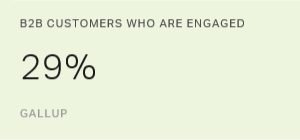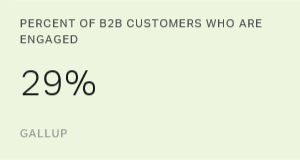Story Highlights
- The best B2Bs put customers at the core of everything they do
- The customer-centric model includes four phases
- Employees must understand what customer centricity means for outcomes
Many business-to-business (B2B) company leaders claim to understand the importance of customer engagement and have a strategy in place to improve it. However, Gallup finds that B2B companies have only managed to engage 29% of their customers. Of their remaining customers, 60% are indifferent and 11% are actively disengaged.

Faltering engagement poses a serious problem for B2Bs. Businesses looking to grow by buying up other companies are likely to see their acquisition strategy hit a wall. Gallup recommends a strategy of organic growth -- getting much more business from existing customers.
So for B2B leaders, where is the disconnect between their companies' stated customer strategies and actual outcomes?
Putting the Customer at the Core of Everything
In Gallup's experience, the very best B2B leaders take a customer-centric approach to engaging customers. This approach puts the customer at the core of everything, which requires more than just focusing on customers or having a defined customer experience. Gallup believes that customer centricity provides the surest path to customer engagement.
Though an increasing number of B2B companies realize they need to be customer-centric to compete in today's market and create organic growth, not all have figured out how to act on this knowledge. Gallup has found that developing a customer-centric model comes down to four phases: discovery, diagnostic, analytic and sustainment. Within each of these phases, there are tasks that companies can execute to understand and act on the voice of the customer.
Discovery. This phase involves evaluating the current state of customer relationships. Some of the tasks associated with this phase include:
- conducting stakeholder analyses to understand the current customer landscape
- identifying the B2B company's needs and priorities
- exploring the B2B company's existing world, including its account structure, its organizational language and culture, and any prior metrics used to evaluate customer relationships
- building or refining a customer engagement and impact strategy
- creating a customer list and relationship map
Diagnostic. This phase involves conducting qualitative and quantitative analyses. Some of the tasks associated with this phase include:
- conducting a key account review
- gathering key account review findings to gain insight into customer accounts
- using key account review insights to make recommendations
- sharing best practices based on insights and recommendations
- carrying out an ethnographic study of customers
- identifying key priorities for customers
Analytic. This phase synthesizes the findings and insights from the discovery phase to identify the key drivers of the customer experience and how the B2B company is performing on them. Some of the tasks associated with this phase include:
- identifying the key drivers that propel the customer relationship forward
- gauging the company's success with the key drivers
- linking the key drivers to customers' priorities and conducting a gap analysis
- making connections among the findings from the discovery phase
Sustainment. This phase pinpoints specific steps to take to improve the customer experience. Some of the tasks associated with this phase include:
- creating an action plan to transform the customer experience
- identifying quick wins to improve the customer relationship
- implementing a strategy to communicate the results throughout the company
- communicating progress with customers to ensure they understand the company's efforts to improve the relationship
The Predominant Factor: People
Of course, there is one predominant factor in a customer-centric model: people. It is critical that B2B employees at all levels -- including leaders, managers and individual contributors -- understand what customer centricity means for the business and how they can deliver on it.
- Leaders must hear the voice of the customer to improve the company's customer relationships and its business outcomes. Leaders need to take accountability for generating a holistic culture shift and for creating processes to build strong, vital relationships that support business results.
- Managers set the tone for improving customer relationships by targeting the key drivers with the greatest impact on customers' overall experience.
- Individual contributors who work daily with client contacts are the face of a company. Helping individual contributors understand the importance of improving the customer relationship is the ultimate catalyst for creating change.
As a B2B company moves through the four phases of a customer-centric model, it must provide employees with the education, training and tools they need to play their part in improving the customer experience. For example, during the discovery phase, leaders should develop an in-depth understanding of customer engagement and impact -- and how they work together to strengthen customer relationships. In the diagnostic phase, managers should attend training on how to set their account teams up for success.
Customer centricity will help improve customer engagement and ultimately generate the organic growth that businesses urgently need.
A version of this article originally appeared in CustomerThink magazine.

